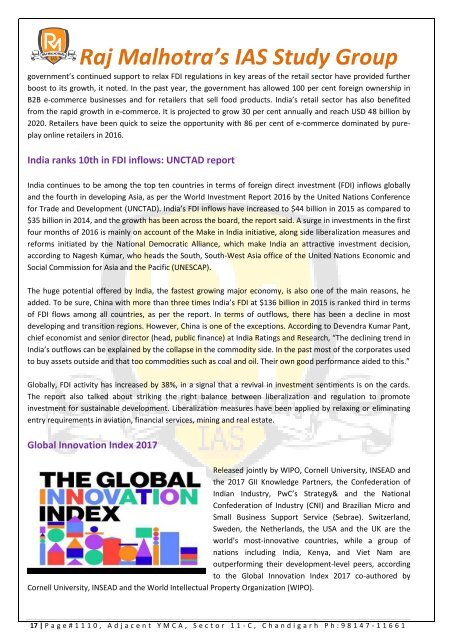Create successful ePaper yourself
Turn your PDF publications into a flip-book with our unique Google optimized e-Paper software.
Raj Malhotra’s IAS Study Group<br />
government’s continued support to relax FDI regulations in key areas of the retail sector have provided further<br />
boost to its growth, it noted. In the past year, the government has allowed 100 per cent foreign ownership in<br />
B2B e-commerce businesses and for retailers that sell food products. India’s retail sector has also benefited<br />
from the rapid growth in e-commerce. It is projected to grow 30 per cent annually and reach USD 48 billion by<br />
2020. Retailers have been quick to seize the opportunity with 86 per cent of e-commerce dominated by pureplay<br />
online retailers in 2016.<br />
India ranks 10th in FDI inflows: UNCTAD report<br />
India continues to be among the top ten countries in terms of foreign direct investment (FDI) inflows globally<br />
and the fourth in developing Asia, as per the World Investment Report 2016 by the United Nations Conference<br />
for Trade and Development (UNCTAD). India’s FDI inflows have increased to $44 billion in 2015 as compared to<br />
$35 billion in 2014, and the growth has been across the board, the report said. A surge in investments in the first<br />
four months of 2016 is mainly on account of the Make in India initiative, along side liberalization measures and<br />
reforms initiated by the National Democratic Alliance, which make India an attractive investment decision,<br />
according to Nagesh Kumar, who heads the South, South-West Asia office of the United Nations Economic and<br />
Social Commission for Asia and the Pacific (UNESCAP).<br />
The huge potential offered by India, the fastest growing major economy, is also one of the main reasons, he<br />
added. To be sure, China with more than three times India’s FDI at $136 billion in 2015 is ranked third in terms<br />
of FDI flows among all countries, as per the report. In terms of outflows, there has been a decline in most<br />
developing and transition regions. However, China is one of the exceptions. According to Devendra Kumar Pant,<br />
chief economist and senior director (head, public finance) at India Ratings and Research, “The declining trend in<br />
India’s outflows can be explained by the collapse in the commodity side. In the past most of the corporates used<br />
to buy assets outside and that too commodities such as coal and oil. Their own good performance aided to this.”<br />
Globally, FDI activity has increased by 38%, in a signal that a revival in investment sentiments is on the cards.<br />
The report also talked about striking the right balance between liberalization and regulation to promote<br />
investment for sustainable development. Liberalization measures have been applied by relaxing or eliminating<br />
entry requirements in aviation, financial services, mining and real estate.<br />
Global Innovation Index <strong>2017</strong><br />
Released jointly by WIPO, Cornell University, INSEAD and<br />
the <strong>2017</strong> GII Knowledge Partners, the Confederation of<br />
Indian Industry, PwC’s Strategy& and the National<br />
Confederation of Industry (CNI) and Brazilian Micro and<br />
Small Business Support Service (Sebrae). Switzerland,<br />
Sweden, the Netherlands, the USA and the UK are the<br />
world’s most-innovative countries, while a group of<br />
nations including India, Kenya, and Viet Nam are<br />
outperforming their development-level peers, according<br />
to the Global Innovation Index <strong>2017</strong> co-authored by<br />
Cornell University, INSEAD and the World Intellectual Property Organization (WIPO).<br />
17 | P a g e # 1 1 1 0 , A d j a c e n t Y M C A , S e c t o r 1 1 - C , C h a n d i g a r h P h : 9 8 1 4 7 - 1 1 6 6 1





